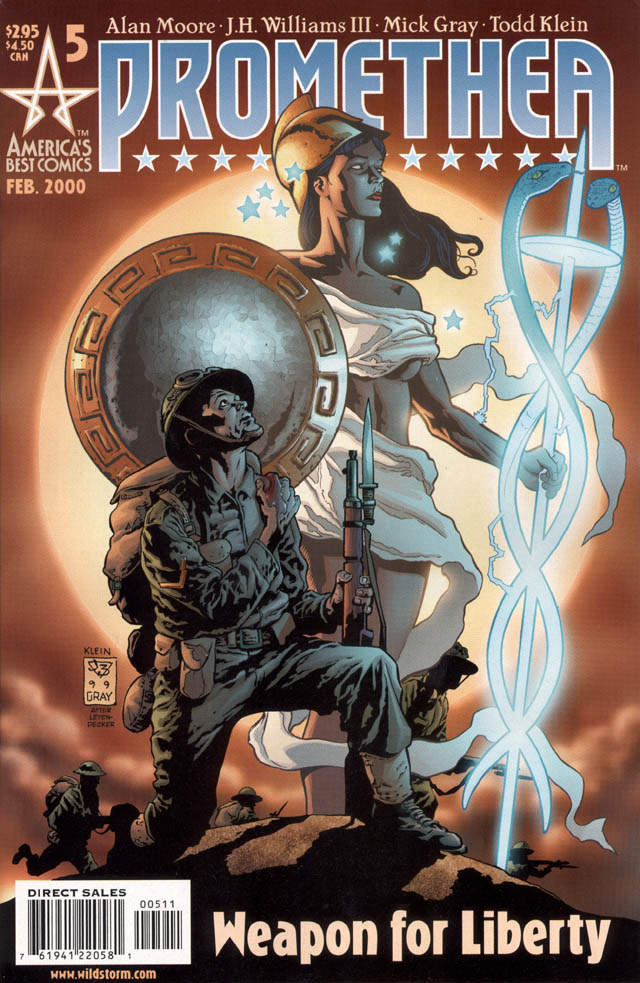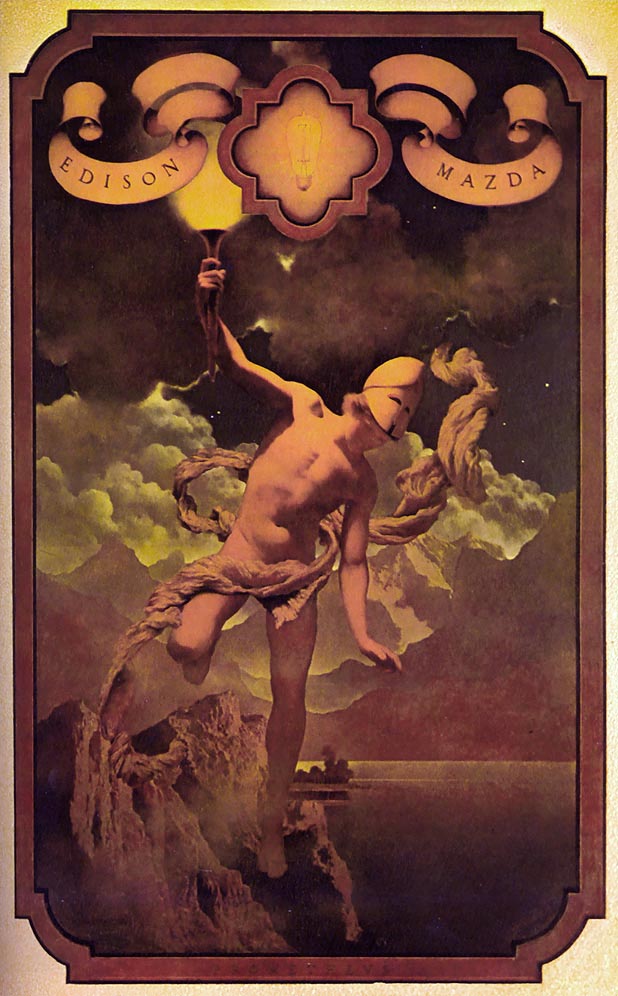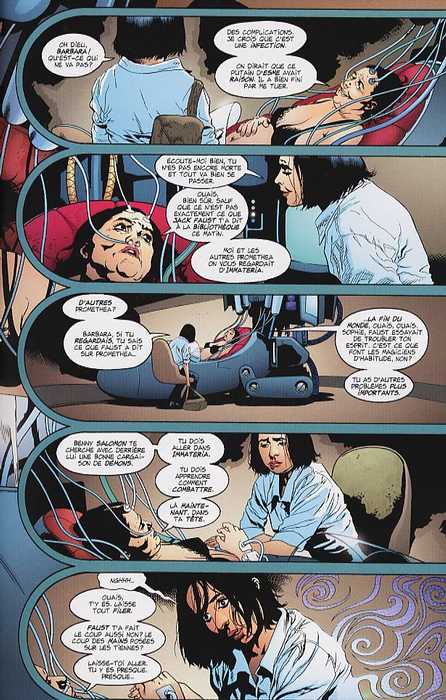
February 2000
(24 pgs.)


which can be seen at the War Posters of the 20th Century site.
Thanks to Jose Villarubia for pointing out that Promethea's depiction in this version is very reminiscent of Maxfield Parrish's artwork for Prometheus.

Parrish was also the inspiration for the cover of Issue #13.
TITLE:
As explained here although the
phrase No Man's Land predates the 1914-1918 conflict it is most commonly
associated with WWI.
No man's land represented the area of ground between
opposing armies - in World War I this meant between trenches.
SYNOPSIS
At Ypres in 1915 Promethea leads a lost soldier back to
safety. Meanwhile back in New York 1999 Barbara's conditioning is worsening.
Barbara helps Sophie return to the Immateria where Margaret explains about the
end of the world. Left alone Sophie finds herself in Hy Brasil.
QUOTES
"God's universe is not itself unkind" - Promethea, pg.
1
"I can't place your voice. Sometimes you sound like an Arab and sometimes
like a Yank" - WWI soldier, pg. 3
"You're an enormous homophobic closet
lesbo" - Stacia to Sophie, pg 5
NOTE: More quotes still to be added before
page finally frozen
NOTES & ANNOTATIONS
Page 1, Panel 1: Ypres, 1915. In
April of that year the Second
battle of Ypres occured
Pages 4-5, Top Panel: School of Elevated
Minds - I think all of us would have liked to attend this school.
Statue on
right hand side reminds me of the Top Ten universe.
Page 4, Panel 2:
Helen Cixous and
some more information about her can be found here.
Here are
some more quotes from the English translation of Le livre de Promethea:

"One cannot bear to spend a Season in Paradise without crying out in
instant nostalgia: never will we have the strength to endure such intoxicating
agony a second time. If we had what we will never have - time to live this day
over again - there are so many others desirable and each is the most beautiful
one. It is superhuman torture. We do not know how, simply, to bear it. We weep
for joy."
"Write on what is alive? But up to now I thought of myself as
writing on paper. Sometimes the paper was thick enough, in fact, for me not to
feel the blood flowing under the skin, under the paper. […] I warn her: ‘I am
writing on you, Promethea, run away, escape. I am afraid to write you, I am
going to hurt you.’ […] But rather than run away, she comes at a gallop. Through
the window she comes, breathing hard, and alive as can be, she flings herself
into the book, and there are bursts of laughter and splashes of water
everywhere, on my notebook, on the table, on my hands, on our bodies..."
"I
loved you in the darkness at the center of the light"
Myth and Legends of the First World War: There is a book
with this title written by James Hayward but it was first published in March
2002.
Page 4, Panel 3: the first Painted Doll T-shirt seen. Smiley
clowns' face with 1 million killed.
Here is a sketch drawn by JHW3
found on pg. 45 of The ABC Sketchbook.

Page 6, Panel 2: Note Kenneth is wearing a 5 badge as a member of the 5 swell guys.

Pages 8-9 top panel: The sun in the sky doesn't look too happy.
The
Pandeliriums will land on the fingers of the hand seen here on panel 4.
Note
the mask on the wall by the pink waterfall and the green loch ness monster like
creature in the water.
Nice effect of bees turning into tigers and thistles
becoming soap bubbles which then turn into baseballs.
Page 9, Panel 4
There's no such word as pandelirium which seems to be a conjunction of
pandemonium and delirium. There used to be a rock band with that
name.
Page 10: The sun panel here looks much happier than the one on
the previous page. Maybe he's glad the pandeliriums are being driven
away.
Page 11: Alan Moore explained about Reality on TV once. Here is
a transcript of what he said some of it quite relevant to the world of
Promethea:
This document was written for TV by Alan moore, as such it
forms a good introductory passage.
Reality, at first glance, is a simple
thing: the television speaking to you now is real. Your body sunk into that
chair in the approach to midnight, a clock ticking at the threshold of
awareness. All the endless detail of a solid and material world surrounding you.
These things exist. They can be measured with a yardstick, a voltammeter, a
weighing scale. These things are real. Then there's the mind, half-focused on
the TV, the settee, the clock. This ghostly knot of memory, idea and feeling
that we call ourself also exists, though not within the measurable world our
science may describe. Consciousness is unquantifiable, a ghost in the machine,
barely considered real at all, though in a sense this flickering mosaic of
awareness is the only true reality that we can ever know. The Here-and-Now
demands attention, is more present to us. We dismiss the inner world of our
ideas as less important, although most of our immediate physical reality
originated only in the mind. The TV, sofa, clock and room, the whole
civilisation that contains them once were nothing save ideas. Material existence
is entirely founded on a phantom realm of mind, whose nature and geography are
unexplored. Before the Age of Reason was announced, humanity had polished
strategies for interacting with the world of the imaginary and invisible:
complicated magic-systems; sprawling pantheons of gods and spirits, images and
names with which we labelled powerful inner forces so that we might better
understand them. Intellect, Emotion and Unconscious Thought were made divinities
or demons so that we, like Faust, might better know them; deal with them; become
them. Ancient cultures did not worship idols. Their god-statues represented
ideal states which, when meditated constantly upon, one might aspire to. Science
proves there never was a mermaid, blue-skinned Krishna or a virgin birth in
physical reality. Yet thought is real, and the domain of thought is the one
place where gods inarguably exist, wielding tremendous power. If Aphrodite were
a myth and Love only a concept, then would that negate the crimes and kindnesses
and songs done in Love's name? If Christ were only ever fiction, a divine Idea,
would this invalidate the social change inspired by that idea, make holy wars
less terrible, or human betterment less real, less sacred? The world of ideas is
in certain senses deeper, truer than reality; this solid television less
significant than the Idea of television. Ideas, unlike solid structures, do not
perish. They remain immortal, immaterial and everywhere, like all Divine things.
Ideas are a golden, savage landscape that we wander unaware, without a map. Be
careful: in the last analysis, reality may be exactly what we think it is.
I forget where I originally found this quotation but it's out on the net
somewhere.
The idea of chairs idea is a famous philosophical discussion
usually covered in early philosophy classes and probably originates from Plato
and his description of people chained at the bottom of a cave and thinking the
shadows on the wall are reality
The idea of private imagination vs. public
imagination dates back to at least ancient Greece and probably further. The SF
writer Philip K Dick knew about it
from his philosophical researches and he refered to the Koinos Kosmos and the
Idios Kosmos in his article on Schizophrenia and the
Book of Changes
"In many species of life forms, such as the grazing
animals, a newborn individual is more or less thrust out into the koinos kosmos
(the shared world) immediately. For a lamb or a pony, the idios kosmos (the
personal world) ceases when the first light hits his eyes--but a human child, at
birth, still has years of a kind of semireal existence ahead of him: semireal in
the sense that until he is fifteen or sixteen years old he is able to some
degree to remain not thoroughly born, not entirely on his own; fragments of the
idios kosmos remain, and not all or even very much of the koinos kosmos has been
forced onto him as yet. The full burden of the koinos kosmos does not weigh
until what is delightfully referred to as "psychosexual maturity" strikes, which
means those lovely days during high school epitomized by asking that cute girl
in the row ahead of you if she'd like to go get a soda after school, and she
saying "NO". That's it. The koinos kosmos has set in. Prepare, young man, for a
long winter. Much more--and worse--lie ahead"
Cheerful soul wasn't
he?
Pages 12-13: Nice layout with introductory panel at top left and
exit panel at bottom right and 6 normal panels in between them.
Page 12
Top Panel:Giant Ice cream cones, top hats and ladies hats and bow ties
sprouting like flowers.
Also notes the Sky Eyes and the just visible clock
face.
Page 13 bottom panel: Giant snails with WWI German helmets. Not
sure about the patterns on the helmets. Are they familiar to anyone?
An
archway of roses and barbed wire leading onto the next double page
splash
Pages 14-15 Top Panel: Swastika on what looks like a tombstone,
roses dripping blood, hammer and sickle in the sky, a few human torsos in front
of the swastika , a floor of skulls, crucifixes stand out in front of the sun,
warheads, black crows and one giant black crow with blood on its' beak, a
saluting army officer (note that the warhead appear to be exploding out of his
pants with the zipper undone) and a sword on the right hand page.
Note that
the only the soldiers legs and helmets are seen. The two opposing armies wear
different helmets.
Reading from left to right how many flags of the world can
you identify?:
Crab Link
Another Crab
link
{Masked crab} (Zo["o]l.), a European crab ({Corystes cassivelaunus})
with markings on the carapace somewhat resembling a human face.
from Hyperdictionary entry on
masked
By contrast I'm not aware of any legends of Seagulls with white
gloves for wings and wristwatches on their bodies
Page 24: Hy Brasil
Source
When
discussing underwater lore and legends, Atlantis is an obvious subject of
interest. However, the lost island of Hy-Brasil is just as intriguing and has
more first-person accounts.
Hy-Brasil is also spelled Hy-Breasal, Hy-Brazil,
Hy-Breasil, Brazir and related variations and refers to the Irish Atlantis. It
may be the reason that the South American country, Brazil, was so named. The
central image on the Brazilian flag, a circle with a channel across the center,
is the symbol for Hy-Brasil on early maps.
The name of Hy-Brasil may come from the Middle Ages term brazil, which seems to indicate a source of rare red dye. The dye may have acquired its name from the legendary island, or vice versa.
Or, the name Hy-Brasil, also called the Fortunate Island, may originate with the old Irish word, breas, meaning noble or fortunate.
In folklore, this island country takes its name from Breasal, the High King of the World, in Celtic history.
(He may or may not be related to Bresal Echarlam mac Echach Baethlaim, from the stories of Lugh at Tara. He was not St. Breasal, although pre-Christian folklore may be the foundation for that saint's legends.)
Hy-Brasil was noted on maps as early as 1325, when Genoese cartographer Dalorto placed the island west of Ireland. On successive sailing charts, it appears southwest of Galway Bay.
On some 15th century maps, islands of the Azores appear as Isola de Brazil, or Insulla de Brazil.
After 1865, Hy-Brasil appears on few maps since its location could not be verified.
Regardless of the name or location, the island's history is consistent: It is the home of a wealthy and highly advanced civilization. Those who visited the island returned with tales of gold-roofed towers and domes, healthy cattle, and opulent citizens.
The lore of Hy-Brasil is equally fascinating. For example, it is shrouded in fog or perhaps beneath the ocean, and appears only briefly, once every seven years.
The island has been visited by many people for centuries. Both Saint Barrind and Saint Brendan found the island on their respective voyages, and returned home with nearly identical descriptions of Hy-Brasil, which they dubbed the "Promised Land."
One of the most famous visits to Hy-Brasil was in 1674 by Captain John Nisbet of Killybegs, Co. Donegal, Ireland. He and his crew were in familiar waters west of Ireland, when a fog came up. As the fog lifted, the ship was dangerously close to rocks. While getting their bearings, the ship anchored in three fathoms of water, and four crew members rowed ashore to visit Hy-Brasil.
They spent a day on the island, and returned with silver and gold given to them by an old man who lived there. Upon the return of the crew to Ireland, a second ship set out under the command of Alexander Johnson.
They, too, found the hospitable island of Hy-Brasil and returned to Ireland to confirm the tales of Captain Nisbet and crew.
The last documented sighting of Hy-Brasil was in 1872, when author T. J. Westropp and several companions saw the island appear and then vanish. This was Mr. Westropp's third view of Hy-Brasil, but on this voyage he had brought his mother and some friends to verify the existence of Hy-Brasil.
Researchers and archaeologists have searched in the most likely locations west of Ireland, and there is evidence that islands existed there. Shallow-water shells have been found at Porcupine Bank, somewhat northwest of the most likely location of Hy-Brasil. Even further north, similar shells were discovered at Rockhall.
So, there is evidence of land mass changes in that part of the Atlantic Ocean.
The most distinctive geographical feature of Hy-Brasil, is that it appears on maps as a perfect circle, with a semi-circular channel through the center. The circular perimeter of the island was confirmed by both Saints Barrind and Brendan, who separately walked the shore to determine where the island ended, but never found it. Most likely, they were walking in circles.
Although Hy-Brasil does not have the fame of Atlantis, outside role-playing games, it is a story worth exploring.
Other names for Hy-Brasil: Tir fo-Thuin (Land Under the Wave), Mag Mell (Land of Truth), Hy na-Beatha (Isle of Life), and Tir na-m-Buadha (Land of Virtue). Fourteeth and Fifteenth century maps spell Hy-Brasil as Ysole Brazil, Bracir, and Hy Breasail. References:
Phantom Islands of the Atlantic, by Donald S. Johnson Dictionary of Celtic Mythology, by Peter Berresford Ellis Celtic Myth and Legend, by Mike Dixon-Kennedy
Above information taken from Suite 101.com The author was Eibhlin MacIntosh.
The images at the bottom of the page look vaguely Aztec to me
Amazing Grace is a well
known hymn. Here the Grace being referred to is Grace Brannagh. Strangely enough
issue #6 is not entitled Amazing Grace at all.